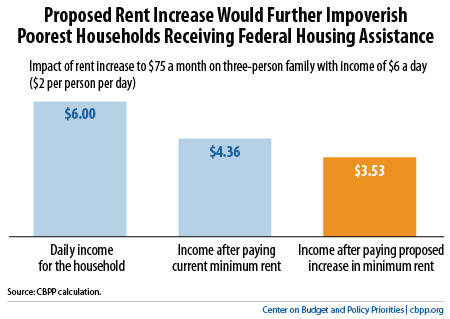más allá de los números
President’s Budget Would Hike Rents on Poorest Households
More than half a million of the nation’s poorest families would face higher rents under the President’s proposal to raise the minimum rent in the rental assistance programs that the Department of Housing and Urban Development (HUD) administers.
Our new report takes a detailed look at the proposal, including its
. The affected families include 725,000 children and are disproportionately minority.The proposal to raise the minimum rent from a maximum of $50 to a mandatory $75 a month — with no discretion for state and local housing agencies to set a lower required payment — would have the biggest impact in states that
to the most vulnerable families and individuals.Nationally, about 12 percent of households receiving HUD-funded rental assistance would face higher rents. But the percentage ranges from nearly 24 percent in Tennessee, which has the nation’s second-lowest TANF benefit level as a share of the poverty line and no General Assistance program, to 2 percent in New York — which has the nation’s highest TANF benefit (48.8 percent of the poverty line ) and is one of only 12 states that provide General Assistance benefits to childless employable adults.

As I noted earlier, this proposal comes even as a study finds that the number of U.S. families with children living on less than $2 per person a day — a standard the World Bank uses to measure serious poverty in third-world countries — has more than doubled since the mid-1990s, to roughly 1.5 million. For a family of three at that level (that is, living on $6 a day), a $25 per month rent increase means that it will have only $3.53 per day to spend on other necessities, as the graph shows.
In fact, the graph almost perfectly illustrates the impact in Tennessee, where a family of three receives only $185 a month in TANF benefits — or about $2 per person per day.
The worsening of severe poverty rebuts the Administration’s rationale that minimum rents should rise to reflect inflation. Rents have indeed gone up in recent years, but the incomes of extremely poor families generally haven’t, because of stagnating wages and shrinking cash assistance.
The Administration’s claim that its proposal is needed to save money doesn’t hold up either. For various reasons, the proposal would likely save less than half of the Administration’s $150 million estimate next year. Surely policymakers can find a better way to secure $75 million than by making some of the poorest Americans still more destitute.
